Sainte-Cécile Cathedral in Albi
Since 2010, the UNESCO World Heritage Committee has recognized the exceptional universal value of the Albigensian site, the Episcopal City ranks among the high places of the Cultural Heritage of Humanity throughout the world.
The Sainte Cécile Cathedral is a true museum of Christian art. It is the only cathedral in Europe whose walls and vaults are entirely painted over an area covering approximately 18,500 m2.

Click on the image to enlarge

The organ case by Christophe Moucherel from the 18th century.

Click on the image to enlarge

Click on the image to enlarge
Its dimensions of interest (16,40m wide - 15,30m high) and the variety of the decorations rank among one of the most beautiful in France.

Click on the image to enlarge
The painting under the organ represents the Last Judgment . This set is remarkable for its surface, for its quality and its mirror arrangement (Creation of the world / Last Judgment). This gigantic painting of the Last Judgment (1474-1484) originally covered 270 m2. Painted in tempera , we distinguish three registers: heaven, earth and hell where the wicked gesticulate in the compartments dedicated to the seven deadly sins .
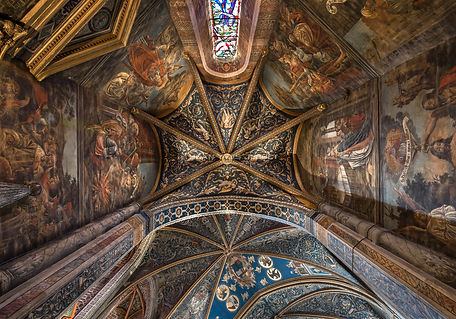
More details

Click on the image to enlarge

Click on the image to enlarge
The frescoes of the vault of Italian Renaissance style, carried out in only 3 years from 1509 to 1512, represent the celestial vault: this deep blue, of mineral origin, this famous “ blue of France ” which is also called “royal blue” Is remarkable.
These frescoes, rich in colors and with exceptional dimensions (97 m long and 28 m wide) form the largest and oldest ensemble in France.

Cliquez sur l’image pour l’agrandir
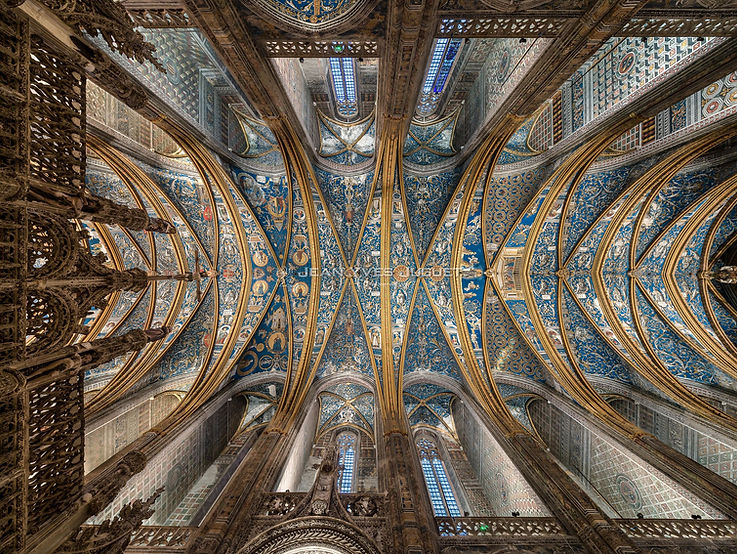
Cliquez sur l’image pour l’agrandir
Véritable encyclopédie biblique sur fond bleu et or, évocation du ciel autour du Christ en Gloire. Elles n'ont jamais été restaurées.

Cliquez sur l’image pour l’agrandir

Click on the image to enlarge
The main entrance, which once stood to the west, as tradition dictates, is now to the south (since the end of the 15th century). It was at this time that, in a late Gothic style , a canopy was added to this door. The latter breaks the unity of the wall: the richness of the decor contrasts with the rigor of the walls of the cathedral, and the color of the stone used, white, (limestone) contrasts with the red of the brick.
In the ambulatory, around the Choir are 33 statues from the Old Testament.
Inside the latter, the 12 statues represent the apostles of the New Testament, as well as the Virgin, Saint John the Baptist and Saint Paul.
.jpg)
Click on the image to enlarge

Click on the image to enlarge
Old Testament characters

Click on the image to enlarge
the New Testament Apostles inside the Choir
The axial chapel (or apse) offers its place of honor to the Virgin Mary; since the 17th century, the Blessed Virgin has shared this place with Sainte-Cécile, whose local brotherhood has its headquarters there. The real chapel of Ste Cécile was originally identified with that of Ecce Homo
In the year 1792 after a timely intervention by the Albigensian engineer JF Mariès, Minister Roland saved the sculptures and paintings of this church doomed to destruction by the directory of the Tarn department in hatred of superstition.
"In memoriam et exemplum"

Click on the image to enlarge
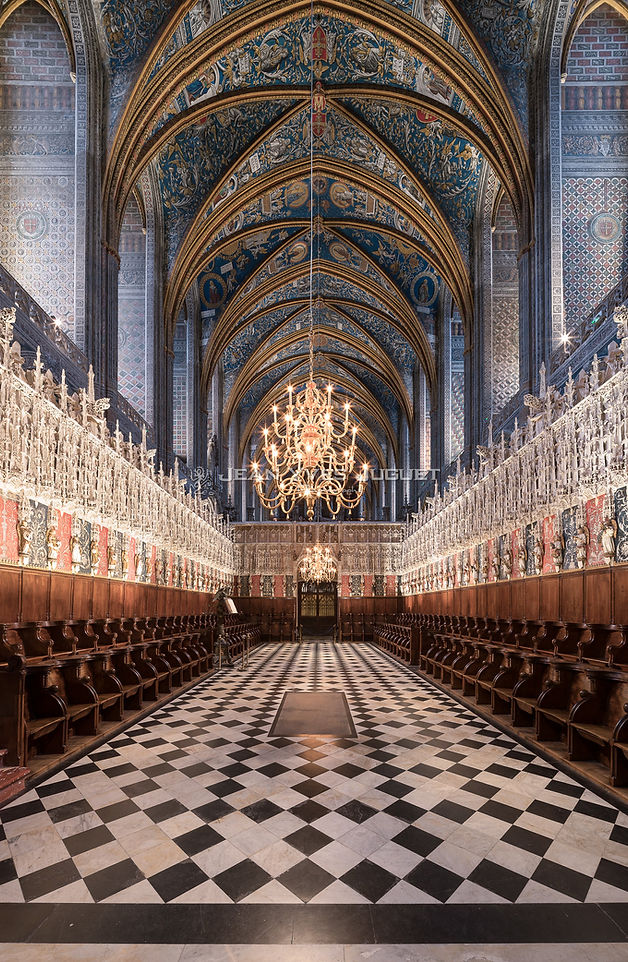
Click on the image to enlarge
The Flamboyant Gothic Grand Choir 1545 - 1585, the polychrome statuary which composes it was produced by the Burgundian workshops of Cluny. Helping to separate religious people from the people, the rood screen or Grand Choir is today the witness of the religious practices of the time. Then by its majesty, it is also the witness of the richness of the Catholic Church The statuary of Ste Cécile forms a considerable whole, perhaps the most important of the French sculpture of the end of the Middle Ages:
- 87 statues on the external facade of the rood screen
- 33 characters from the Old Testament around the choir
- 15 statues representing the Church inside: (12 apostles, the Virgin, St John the Baptist and St Paul)

Cliquez sur l’image pour l’agrandir
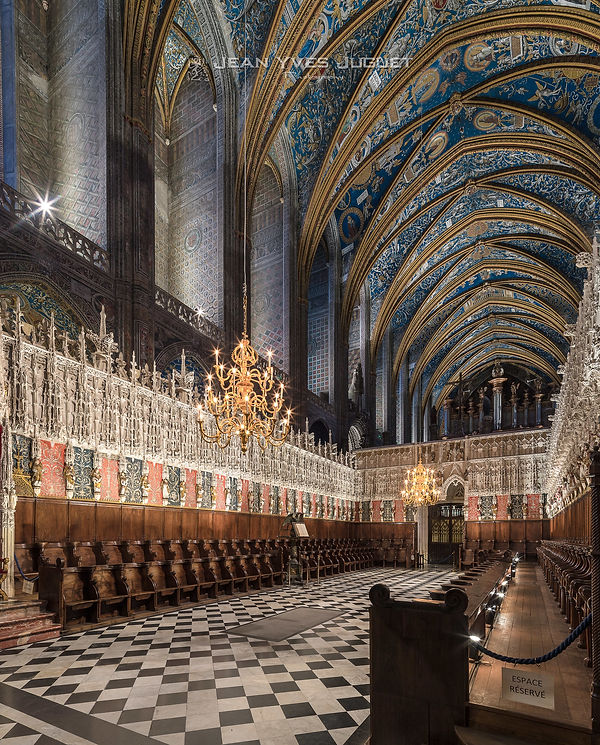
Cliquez sur l’image pour l’agrandir
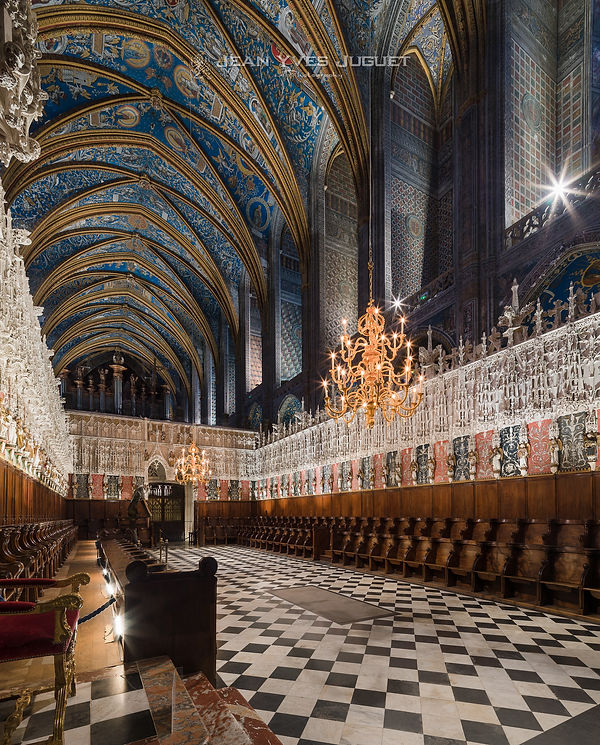
Cliquez sur l’image pour l’agrandir

Click on the image to enlarge
72 statues of angels, Charlemagne and Emperor Constantine dominating the two entrance gates of the fence.
All the statues have retained their original polychromy. The color tends towards naturalism, hair, attitudes and costumes are of an admirable variety. The style of the beards of the faces, of the drapes makes it possible to distinguish three families that could be linked to the art of the great French picture artists of the end of the 15th century: Antoine Le Moiturier and Michel Colombe.

Click on the image to enlarge

Click on the image to enlarge
Vault in the ambulatory, the corridor surrounding the large choir, presents stone statues chiseled by Burgundian masters

Click on the image to enlarge

Click on the image to enlarge
The rood screen, real lace of white stone, fence of the choir is adorned with more than 270 statues chiseled by Burgundian Masters,

Click on the image to enlarge
The ambulatory, the corridor surrounding the large choir, presents stone statues chiseled by Burgundian masters

Cliquez sur l’image pour l’agrandir
Statue de Sainte-Cécile
La statue bien connue de Maderno , datant de 1599, est censée représenter le corps tel qu'il fut retrouvé dans le cercueil. Cette statue se trouve à l'église Sainte-Cécile à Rome ; la cathédrale d’Albi, dédiée à la Sainte, en possède une fidèle réplique.
Les salles du Trésor
Le trésor de la cathédrale est réparti dans deux salles, qui ont été rénovées toutes les deux en 2022 présentant une nouvelle scénographie valorisant le mobilier d’art sacré. On peut découvrir dans la première salle : des reliquaires, des calices, des châsses... et dans la seconde : des vêtements, des ornements liturgiques mais aussi des sculptures.
Quelques tableaux sont présents dans les deux salles

Cliquez sur l’image pour l’agrandir
Acquis par le ministère de la Culture et de la Communication en 2012 auprès d’un collectionneur, le tableau "La Sainte Famille" est accroché dans le trésor de la cathédrale d’Albi et visible par le public.
Peinte vers 1530 et sans doute réalisée à Albi, cette huile sur panneau de chêne (92 x 73 cm) commandée par le chanoine Anne Regin, alors vicaire général d’Albi, est attribuée au peintre anversois Karsten van Limbos. Ce Flamand, connu aussi sous les noms de Christian Valumbres, Valumbras ou Valimboy, fit sans doute un voyage en Italie et s’installa en Provence. Une autre de ces œuvres, Jésus parmi les docteurs déposée au musée de l’Emperi de Salon-de-Provence, présente des ressemblances avec "La Sainte Famille".
La scène est construite autour de la figure de la Vierge qui occupe la place centrale du panneau et tient l’enfant Jésus debout sur son berceau. Celui-ci se tourne vers Jean-Baptiste. À l’arrière se tiennent Élisabeth et Joseph.
Le chanoine Anne Regin avait offert "La Sainte Famille" à la cathédrale de Clermont, ville d’où il était originaire et où il a fini ses jours. La restitution de ce tableau dans la cathédrale de Clermont n’étant pas envisageable aujourd’hui, il a été choisi de le présenter dans le trésor de la cathédrale Sainte-Cécile d’Albi qui s'enrichit ainsi d'une œuvre majeure.
La bonne compréhension de ce tableau, tant d'un point de vue historique qu'artistique, aura nécessité un long travail de recherche de la part d'historiens d’art, de conservateurs des monuments historiques de trois régions (Midi-Pyrénées, Provence-Alpes-Côtes d’Azur et Auvergne) et des conservateurs des antiquités et objets d’art.
La restauration de la couche picturale a été réalisée, avant l'acquisition, par Jacques de Grasset (Avignon) et celle du support par Philippe Duvieuxbourg (Avignon). Pour la présentation à Albi, le châssis-cadre a été conçu par Philippe Hazaël-Massieux (Avignon), les constats d’état et les contrôles de climat ont été réalisés par Hélène Garcia (Gaillac), l’accrochage par Jean-Luc Parrot (Vénès).
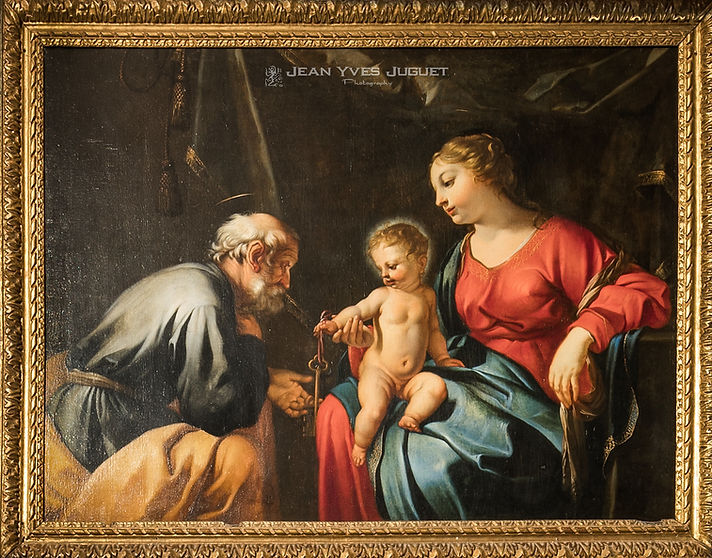
Cliquez sur l’image pour l’agrandir
La Vierge et l'Enfant Jésus remettant les clefs à Saint Pierre, 1628

Cliquez sur l’image pour l’agrandir
Le repentir de Saint Pierre - Fin XVIIe

Click on the image to enlarge






